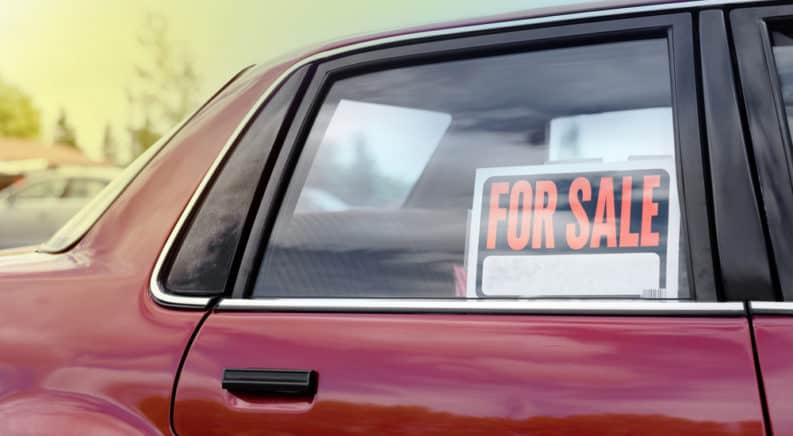When you’re selling your old car it can often be difficult to decide on a price. Of course, you want to make as much as you can, but it’s a delicate balance. You can’t charge too much, or you’ll never find a buyer. You don’t want to charge too little either, or you could end up missing out on a significant amount of money. Beyond picking your price, there’s still a long list of other things to attend to before you can get rid of an old car, and during the process, it can be easy to forget some of the finer details. In an effort to help prevent that kind of oversight, we’ve put together a step-by-step guide to selling used cars, and hopefully, it helps make the whole ordeal a little bit easier.
1. Determine the Value of Your Car
Of course, the first and foremost task is to assess the value of your vehicle. One of the best ways to do this is by checking online listings for models identical or similar to the one you’re planning to sell, and then weighing the average of their asking prices. There’s bound to be a slight variance in the prices you find, and there may be a few odd outliers, but it’s a good place to start. Once you at least have a solid grasp of the price range that your vehicle usually goes for, it should be much easier to confidently set your price.
If you want to take things a step further and pinpoint a more precise estimate, there are a few popular online resources that can help you get that done in no time. Edmunds and Kelley Blue Book both offer appraisal tools that utilize actual sales data to determine their estimates. By comparing the prices that people in your area have paid for the same vehicle, they can provide an evaluation that factors in a vehicle’s color, the condition it’s in, what optional features it has installed, and even it’s mileage. Online appraisals from sites like these can never be 100% accurate, but they’re the closest thing there is to it.
2. Prepare Yourself
There are a few documents you should try to have on hand early on, even if you know you won’t need them until later. There’s nothing worse than dashing around at the last minute in a panicked state trying to get things done, especially when it involves a handful of important documents.
Maintenance Records – These can be requested from whoever serviced your vehicle if you no longer have them.
Vehicle Title – The title establishes a vehicle’s legal owner.
Bill of Sale – You can get a bill of sale from the official DMV website. (No lines online!)
Notice of Transfer and Release of Liability Form – This form documents the transfer of legal responsibility regarding the vehicle being sold.
Warranty Information or As-Is Contract – Depending on the status of the factory/extended warranty, you should be providing your buyer with one of these two things.
3. Prepare Your Car
This one is a no-brainer. Keeping a tidy car is generally good practice even when you aren’t about to sell it, though for some people it can be difficult (myself included). If you’re like me, and your car’s interior is a frustrating reflection of your organizational difficulties, then you might need an entire day to clean everything out. Regardless, it’s absolutely essential that your car look presentable before you start advertising it. Bring it to the car wash or scrub it down yourself, it doesn’t matter either way, as long as it’s clean before any prospective buyers see it.
The last thing you should try to do before beginning to advertise is to visit your mechanic. You can take this opportunity to grab your maintenance records if you haven’t yet, and if your car is in need of any routine service or minor repairs, now is the time. Once they’re finished with whatever upkeep you had them work on, make sure you request a full report of the vehicle’s current condition. Evidence of routine maintenance is a big selling point when it comes to used cars, so if you can provide that to potential buyers, then you might be justified to increase your starting price by a bit.
4. Advertising
By this point your car should be clean and organized enough to finally allow other people to see it. From there the next step is simple; you just need to take some pictures, preferably from as many different angles as possible. Once you think you have enough to get the point across, it’s time to create your advertisement. There is a fair deal of websites to help set up an online classified ad, but Craigslist and eBay are both solid options. Social media sites are also a decent place to leave ads, due in no small part to the number of regional Facebook groups that exist specifically for these kinds of transactions. Regardless of where it gets posted, just remember to leave your asking price and the vehicle’s basic information in the ad!
5. Presenting
Showcasing your vehicle to strangers can be a real mixed bag, so it’s helpful to reassure yourself sometimes by vetting potential buyers through social media. It’s helpful to keep in mind that these situations go both in both directions, and that possible buyers are evaluating you just as often as you’re evaluating them. Try to be a warm presence as a way to offset any awkwardness, and invite questions in case your buyer doesn’t feel comfortable asking unprovoked. There’s a really good chance that they’ll want to try a quick test drive at some point, so it’s nice to throw that suggestion out there as well in case they don’t want to ask. If they decide they want to see how it feels behind the wheel, you should go with them for a drive to answer any questions they may have.
6. Negotiating the Price
In the end, it all comes down to the negotiations. Every person is different though, and there’s no real way to tell how each person will choose to haggle. There are two easy tactics to help deal with how unpredictable negotiations can be, and as long as you remember them both, you should do just fine. It may seem like common sense, and you’ve probably heard it before, but bumping up your starting price gives you more room for flexibility during negotiations. Dropping in price to satisfy a buyer is undoubtedly more comfortable when you have yet to dip below your original starting number. Setting a minimum sufficient dollar value and keeping it in mind is an efficient method of limiting how far you allow negotiations to go before cutting them off. It has to be a strict cut-off point, though, or else you risk defeating the purpose of the minimum, to begin with.
7. Finalizing the Sale
Remember way back, during step two, when I told you to gather that list of documents? Well, hopefully you kept them somewhere safe because all that’s left to do at this stage is finish filling them out. Once you’ve completed the bill of sale and signed over the title, you’ve officially sold your car! After all the other paperwork is done, the only thing left to do is take your cash or check to the bank and then relax.
Selling Used Cars Doesn’t Have To Be Hard!
After having read these tips, you should feel more confident about taking the steps required to sell your old car without spending extra energy worried about organization. If not, try getting some help from a friend. Selling your car can be a large undertaking, and sometimes having someone you trust at your side makes things feel more manageable. Either way, we wish you the best of luck.




